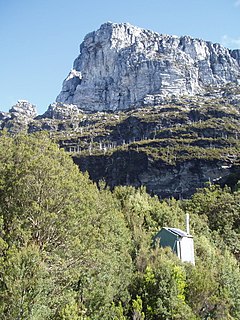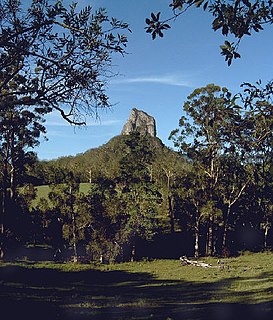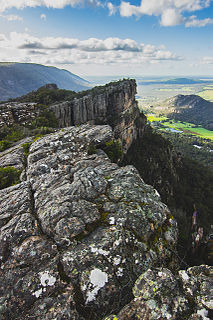 W
WThe Blue Mountains are a mountainous region and a mountain range located in New South Wales, Australia. The region borders on Sydney's metropolitan area, its foothills starting about 50 kilometres (31 mi) west of centre of the state capital, close to Penrith on the outskirts of Greater Sydney region. The public's understanding of the extent of the Blue Mountains is varied, as it forms only part of an extensive mountainous area associated with the Great Dividing Range. Officially the Blue Mountains region is bounded by the Nepean and Hawkesbury rivers in the east, the Coxs River and Lake Burragorang to the west and south, and the Wolgan and Colo rivers to the north. Geologically, it is situated in the central parts of the Sydney Basin.
 W
WBluff Knoll is the highest peak of the Stirling Range in the Great Southern region of Western Australia (WA). It is 1,099 metres (3,606 ft) above sea level, Although Bluff Knoll is sometimes claimed to be the highest point in Western Australia, the highest peak is actually Mount Meharry in Karijini National Park in the Hamersley Range, which is 1,249 metres (4,098 ft) above sea level.
 W
WBooroomba Rocks is a granite climbing area in Namadgi National Park, in the Australian Capital Territory, particularly noted for its slab climbing. The rocks are divided into several areas, the most prominent being North Buttress, Middle Rocks, and South Buttress.
 W
WFrenchmans Cap is a mountain in the West Coast region of Tasmania, Australia. The mountain is situated in the Franklin-Gordon Wild Rivers National Park.
 W
WThe Freycinet Peninsula is a large peninsula located on the eastern coast of Tasmania, Australia. The peninsula is located north of Schouten Island and is contained within the Freycinet National Park.
 W
WFrog Buttress is a cliff on the north-west side of Mount French, in the Moogerah Peaks National Park near the town of Boonah in Queensland, Australia. It became famous when local rock climbers Rick White and Chris Meadows discovered it in 1968. Since then, 400 routes have been established by climbers including Henry Barber, Kim Carrigan and Tobin Sorenson.
 W
WGlass House Mountains National Park is a heritage-listed national park at Glass House Mountains, Sunshine Coast Region, Queensland, Australia. It is also known as Beerburrum Forest Reserve 1. It is 70 km (43 mi) north of Brisbane and consists of a flat plain punctuated by rhyolite and trachyte volcanic plugs, the cores of extinct volcanoes that formed 27 million to 26 million years ago. The mountains would once have had pyroclastic exteriors, but these have eroded away.
 W
WThe Grampians National Park commonly referred to as The Grampians, is a national park located in the Grampians region of Victoria, Australia. The Jardwadjali term for the mountain ranges themselves is Gariwerd.
 W
WThe Kangaroo Point Cliffs are heritage-listed cliffs located at Kangaroo Point just across the Brisbane River from the Brisbane CBD in Queensland, Australia. A popular recreation spot, especially for climbing and running, they are conveniently close to the city and the South Bank Parklands. It can be reached by the Pacific Motorway, South East Busway or a ferry to Thornton Street ferry wharf. The cliffs were formed after stone was quarried from the site and used in the construction of a number of local structures in the Moreton Bay penal settlement.
 W
WMorialta Conservation Park, formerly the Morialta Falls Reserve and the Morialta Falls National Pleasure Resort, is a protected area 10 km north-east of Adelaide city centre, in the state of South Australia, Australia. The park is in a rugged bush environment, with a narrow gorge set with three waterfalls, bounded by steep ridges and cliffs. The park caters to many activities, including bushwalking, bird watching and rock climbing.
 W
WMount Arapiles is a rock formation that rises about 140 metres (460 ft) above the Wimmera plains in western Victoria, Australia. It is located in Arapiles approximately 10 kilometres (6.2 mi) west of the town of Natimuk and is part of the Mount Arapiles-Tooan State Park. Arapiles is a very popular destination for rock climbers due to the quantity and quality of climbs. It is one of the premier climbing sites in Australia along with the nearby Grampians. The Wotjobaluk name for the formation is Djurid.
 W
WMount Buffalo is moderately tall mountain plateau in the Mount Buffalo National Park in Victoria, Australia that is located approximately 350 kilometres (220 mi) northeast of Melbourne in the Australian Alps.
 W
WThe Mount Buffalo National Park is a national park located in the alpine region of Victoria, Australia. The 31,000-hectare (77,000-acre) national park is located approximately 350 kilometres (220 mi) northeast of Melbourne in the Australian Alps. Within the national park is Mount Buffalo, a moderately high mountain plateau, with an elevation of 1,723 metres (5,653 ft) above sea level.
 W
WPoint Perpendicular is a point at the southern tip of the Beecroft Peninsula and at the northern entry to Jervis Bay, in New South Wales, Australia. It is the location of Point Perpendicular Light, a historic lighthouse which was active from 1889 to 1993, and a replacement skeletal tower which is active.
 W
WProspect Hill is a heritage-listed hill in Pemulwuy and Prospect in the greater western region of Sydney, New South Wales, Australia. Situated about 30 kilometres west of central Sydney, the hill is Sydney's largest body of igneous rock and is higher than the ridges of the Cumberland Plain around it, with its present-day highest point being 117 metres high, although before its summit was quarried away it rose to a height of 131 metres above sea level.
 W
WThe Watagan Mountains or Watagans or Wattagan Mountains, a mountain range that is part of the Great Dividing Range, is located on the Lower Hunter region of New South Wales, Australia. The range is situated between the Upper Hunter River catchment and the Tuggerah Lakes. The Watagans are a popular tourist location and are close to Newcastle, Sydney and the Central Coast.